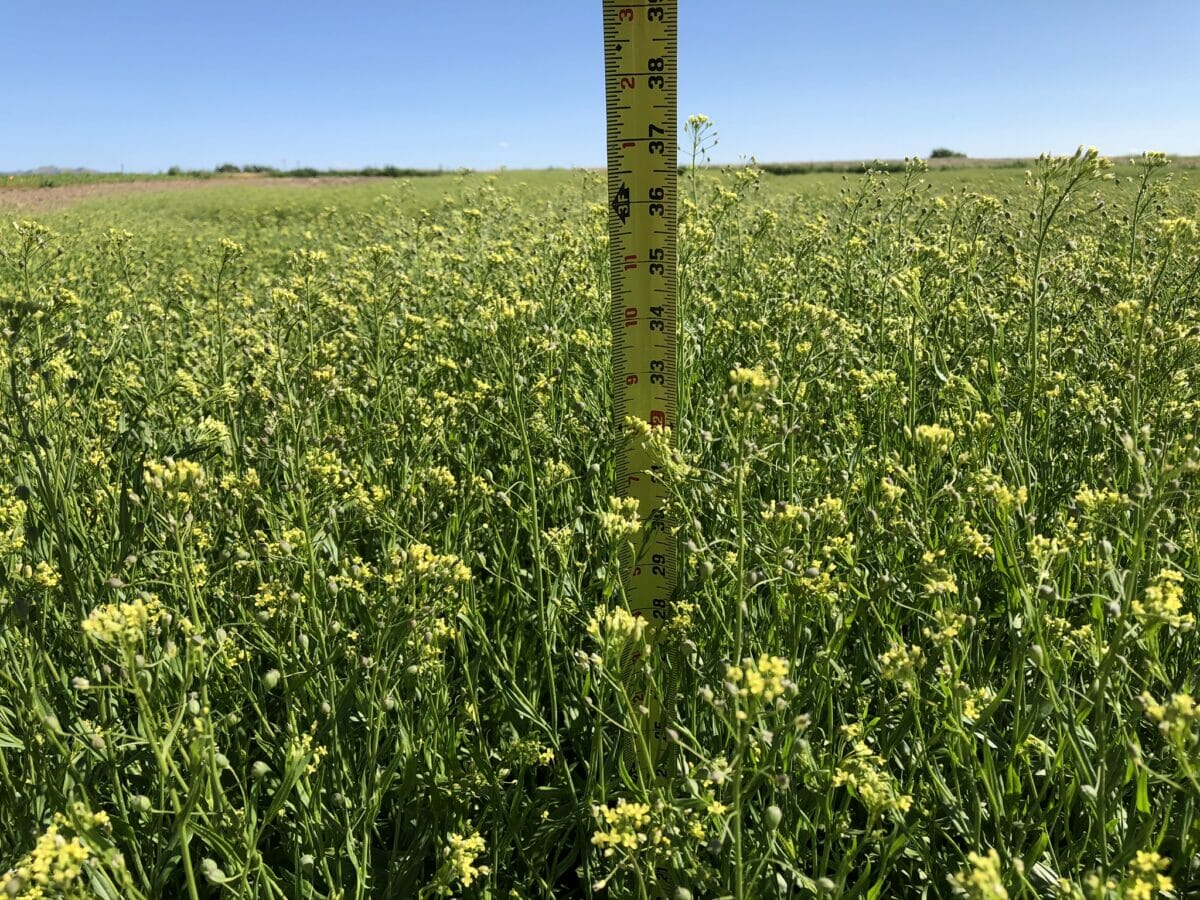The Plant That Grows Plastic
Camelina, an underutilized grain crop, could prove key to the future of renewable bioplastics.
The Plant That Grows Plastic
Camelina, an underutilized grain crop, could prove key to the future of renewable bioplastics.

This bioscience company sees uses for camelina as a cover crop, a plastic producer and even as fish food. courtesy of Yield10.
Camelina sativa, commonly known as camelina or false flax, is a long reedy plant that sprouts about a dozen buds at its tip, which blossom into pale yellow flowers in early summer. Aesthetically, it’s similar to canola or rapeseed. It’s also a hardy plant, suitable for colder climates and perfect for growers in the Canadian prairies or northern US—another trait it shares with canola.
But camelina has one unique feature that sets it apart, which some researchers are banking on: It has the potential to revolutionize the bioplastics industry.
At least, that’s what the folks at Yield10 Bioscience are working toward. The agricultural bioscience company has been researching and developing new camelina varieties and looking at the plant’s application potential across sectors. It sees uses for camelina as a cover crop, a plastic producer and even as fish food.
“It’s a game changer,” says Oliver Peoples, CEO of Yield10, who explains that, because of the earlier successes of rapeseed, canola oil took off and got a greater portion of available funding and development in the past several decades.

But now, our population levels are pushing canola past what it can do. “You’ve got population growth, you’ve got the demand for more oil, more protein, you’ve got the whole renewable fuels area…and we’re already producing all the canola we can produce,” Peoples says. That’s what initially prompted researchers to turn to camelina, which requires fewer supports in terms of fertilizers and water consumption. As it turns out, camelina might also be key to the future of plastic.
A major source of bioplastic is polylactic acid, or PLA. It’s made by fermenting the starch and sugars from crops such as corn, beets and/or sugar cane. From there, lactide molecules in the mixture bond together to form polymers, which can be reconfigured as PLA and used in any number of products.
With camelina, however, Peoples says you can take out that middle step, as the plant does the work for you, creating a polyester called PHA, also known as polyhydroxyalkanoates. The PHA material is both marine and soil biodegradable. “Camelina makes a polymer chain inside the seed. We have to extract that along with the oil and the protein, but what it does is save all the inefficiencies and all the energy costs and all the water required for that downstream work,” says Peoples. “Instead of [plastic] made from plants, it’ll be made by plants.”
Yield10 is also looking at how camelina fares as a cover crop and a winter crop, experimenting with varieties that could extend the plant’s growing season. It is even using camelina oil in feed for livestock and fish, which could change up how commercial aquacultures run. Right now, much of the commercial feed comes from harvested sardines. “We’re making something that’s more or less a replacement for fish oil,” says Peoples. “It’s sustainable and mercury-free because it’s not harvested from the ocean.”
Since the PHA-derived plastics are biodegradable, Peoples says the plastic could be a key product as we continue to shift to more zero-waste and carbon-neutral materials. Although companies such as Yield10 are looking at camelina as the future, it’s unlikely that we’ll see a huge shift in the production of bioplastics tomorrow. Three to five years down the line, however, could prove to be a key time for the crop.
Follow us
This work is licensed under a Creative Commons Attribution-NoDerivatives 4.0 International License.
Want to republish a Modern Farmer story?
We are happy for Modern Farmer stories to be shared, and encourage you to republish our articles for your audience. When doing so, we ask that you follow these guidelines:
Please credit us and our writers
For the author byline, please use “Author Name, Modern Farmer.” At the top of our stories, if on the web, please include this text and link: “This story was originally published by Modern Farmer.”
Please make sure to include a link back to either our home page or the article URL.
At the bottom of the story, please include the following text:
“Modern Farmer is a nonprofit initiative dedicated to raising awareness and catalyzing action at the intersection of food, agriculture, and society. Read more at <link>Modern Farmer</link>.”
Use our widget
We’d like to be able to track our stories, so we ask that if you republish our content, you do so using our widget (located on the left hand side of the article). The HTML code has a built-in tracker that tells us the data and domain where the story was published, as well as view counts.
Check the image requirements
It’s your responsibility to confirm you're licensed to republish images in our articles. Some images, such as those from commercial providers, don't allow their images to be republished without permission or payment. Copyright terms are generally listed in the image caption and attribution. You are welcome to omit our images or substitute with your own. Charts and interactive graphics follow the same rules.
Don’t change too much. Or, ask us first.
Articles must be republished in their entirety. It’s okay to change references to time (“today” to “yesterday”) or location (“Iowa City, IA” to “here”). But please keep everything else the same.
If you feel strongly that a more material edit needs to be made, get in touch with us at [email protected]. We’re happy to discuss it with the original author, but we must have prior approval for changes before publication.
Special cases
Extracts. You may run the first few lines or paragraphs of the article and then say: “Read the full article at Modern Farmer” with a link back to the original article.
Quotes. You may quote authors provided you include a link back to the article URL.
Translations. These require writer approval. To inquire about translation of a Modern Farmer article, contact us at [email protected]
Signed consent / copyright release forms. These are not required, provided you are following these guidelines.
Print. Articles can be republished in print under these same rules, with the exception that you do not need to include the links.
Tag us
When sharing the story on social media, please tag us using the following: - Twitter (@ModFarm) - Facebook (@ModernFarmerMedia) - Instagram (@modfarm)
Use our content respectfully
Modern Farmer is a nonprofit and as such we share our content for free and in good faith in order to reach new audiences. Respectfully,
No selling ads against our stories. It’s okay to put our stories on pages with ads.
Don’t republish our material wholesale, or automatically; you need to select stories to be republished individually.
You have no rights to sell, license, syndicate, or otherwise represent yourself as the authorized owner of our material to any third parties. This means that you cannot actively publish or submit our work for syndication to third party platforms or apps like Apple News or Google News. We understand that publishers cannot fully control when certain third parties automatically summarize or crawl content from publishers’ own sites.
Keep in touch
We want to hear from you if you love Modern Farmer content, have a collaboration idea, or anything else to share. As a nonprofit outlet, we work in service of our community and are always open to comments, feedback, and ideas. Contact us at [email protected].by Emily Baron Cadloff, Modern Farmer
February 12, 2022
Modern Farmer Weekly
Solutions Hub
Innovations, ideas and inspiration. Actionable solutions for a resilient food system.
ExploreExplore other topics
Share With Us
We want to hear from Modern Farmer readers who have thoughtful commentary, actionable solutions, or helpful ideas to share.
SubmitNecessary cookies are absolutely essential for the website to function properly. This category only includes cookies that ensures basic functionalities and security features of the website. These cookies do not store any personal information.
Any cookies that may not be particularly necessary for the website to function and are used specifically to collect user personal data via analytics, ads, other embedded contents are termed as non-necessary cookies.
I seem to remember another crop being tried experimentally , first during WW Ii then in the mid 80’s as a rubber latex substitute. Think it began with a G. Long polymer chain feedstock. Then the jojoba scam, handout programs, and collapse in oil prices chased everyone away.